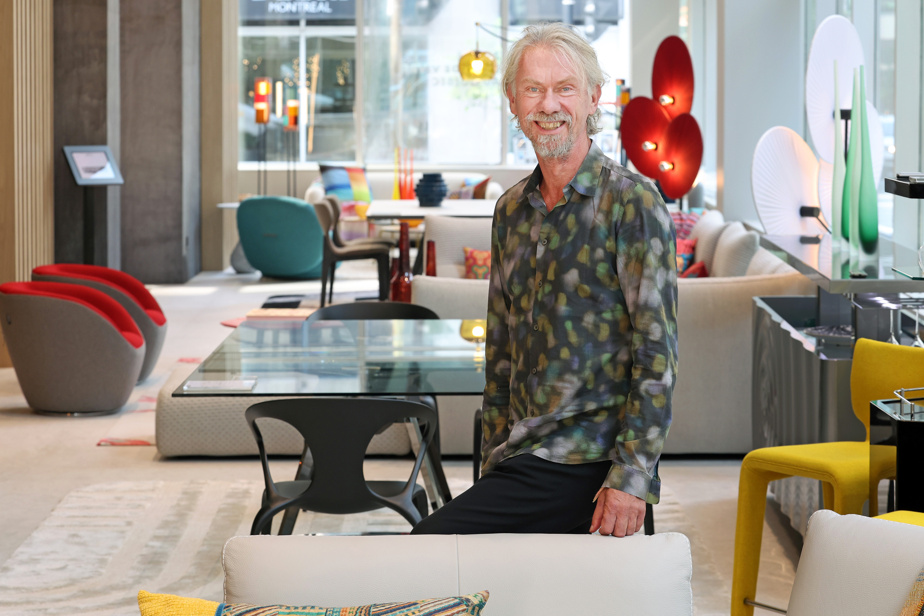Founded in 1960, Roche Bobois is celebrating its 50th anniversary in Quebec. Over the years, the French high-end furniture company has become a reference for know-how in the field of luxury designer furniture and has collaborated with big names in architecture and fashion such as Jean Paul Gaultier, Missoni, Kenzo.
The large boutique in downtown Montreal, completely renovated, was inaugurated by the director of Roche Bobois collections, Nicolas Roche. Son of one of the brand’s co-founders, he was an architect for 20 years before joining the family business.
The Press : The Montreal store, which is celebrating its 50th anniversary, has been renovated.
Nicolas Roche: This new setting was designed with the idea that people feel good there. We try to sell dreams, and we want people to project themselves into this very bright space, there is the fireplace, the green wall, it’s a bit as if we were in a beautiful villa in California on the edge of the sea. ocean, and you have to imagine that Avenue du Président-Kennedy is the Pacific Ocean! [rires]

PHOTO ROBERT SKINNER, THE PRESS
The Roche Bobois boutique is located at 505, avenue du Président-Kennedy, in downtown Montreal.
The Press : What is the history of Roche Bobois?
Nicolas Roche: The history of Roche Bobois was born in 1960 with the desire to bring something new that did not exist in France: Scandinavian furniture which represented modernity. The Roche family met two brothers who owned the Au Beau Bois boutique at the fairs in Copenhagen and decided to join forces to import Scandinavian furniture. Then, very quickly, came the need to develop collections exclusive to Roche Bobois, so they began to work with designers like Pierre Paulin and Marc Berthier. Little by little, they went from importers to publishers and distributors. Designing exclusive collections by creating a brand identity, which has developed over decades.

PHOTO PROVIDED BY ROCHE BOBOIS
The iconic Mah Jong modular sofa which marked the history of Roche Bobois
The Press : Will the arrival of television in the 1970s change the organization of the living room?
Nicolas Roche: Indeed. The television became the center of the living room and the sofa, in the 1970s, became essential. Today, it is the corner sofa that is very successful! In 1971, German designer Hans Hopfer created the Mah Jong sofa, which became iconic. Its principle is flexibility and modularity. You can buy several cushions, arrange them as you want, which allows you to transform the sofa. We want to bring the family together around the television, it is integrated into the layout of the living room. We have a piece of furniture that we sell extremely well called hide and seek, a retractable piece of furniture, which integrates the television which comes out of the piece of furniture, and which fits inside.
-

PHOTO ROBERT SKINNER, THE PRESS
The Bombom collection, signed by Portuguese artist Joana Vasconcelos for Roche Bobois
-

PHOTO ROBERT SKINNER, THE PRESS
The Roche Bobois boutique is very bright, the spaces are vast and reminiscent of a beautiful Californian house.
-

PHOTO ROBERT SKINNER, THE PRESS
The different Roche Bobois collections are on display in the boutique in downtown Montreal.
-

PHOTO ROBERT SKINNER, THE PRESS
The Roche Bobois boutique presents a vast selection of high-end contemporary furniture.
1/4
The Press : What are the biggest challenges today for Roche Bobois?
Nicolas Roche: Roche Bobois is often said to be beautiful, quality heritage furniture with aesthetic value, but that is no longer enough. The furniture must be made with environmentally friendly materials, and if we consider its entire life cycle, that it can be separated, dismantled, recycled and that its end of life is dignified, like a person.

PHOTO ROBERT SKINNER, THE PRESS
Nicolas Roche, director of collections at Roche Bobois
Eco-design is part of the notion of quality of furniture and we must think about it from the first sketches when designing a piece of furniture.
Nicolas Roche, director of collections at Roche Bobois
There is the origin of the materials and the wood from sustainably managed forests, the way the furniture is assembled, the choice of fabrics with certification. Our goal is that by 2025, all our furniture will be eco-designed. We have implemented a certified measurement tool, which evaluates the environmental performance of furniture in eight steps.
The Press : Are Canada and the United States a very big market for you?
Nicolas Roche: The Canada/United States together represents our largest global market today. It’s a growing market, we have opened many stores in the United States, mainly in Florida and California, where there is a certain purchasing power and where houses are large. In Canada, we have strong development in turnover, the year 2022 has been extraordinary.
The Press : How do you explain it?
Nicolas Roche: For everything related to home design, for all players in the sector, the pandemic has been beneficial, but even more in Canada than elsewhere, perhaps because of the climate, you spend even more time in your homes. It was a difficult period with a lot of pain, but for the furniture sector, it was a period of total reinvestment of the family life unit and a reorientation of available money towards the comfort and pleasure of being at home. self.
The Press : What do you see for the future?
Nicolas Roche: We will have to understand the changes in the world and know how to support them. Everything is moving very quickly, there is artificial intelligence, teleworking, 3D printing, everything that will revolutionize our relationship with objects, new modes of consumption, eco-design. We will have to go ever further, and be able to respond to all aspects of life, beyond furniture and housing.
